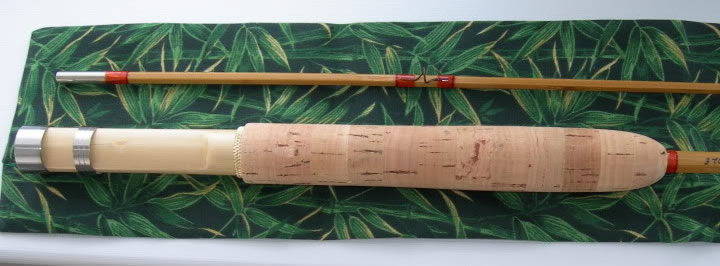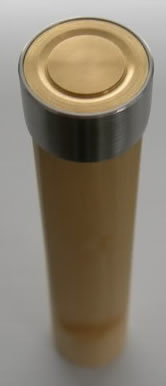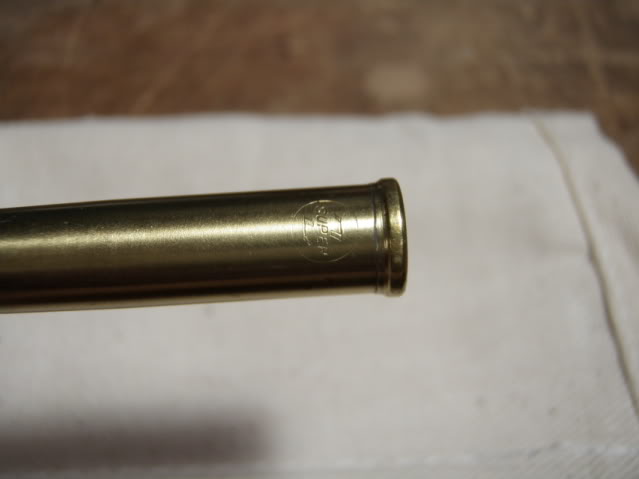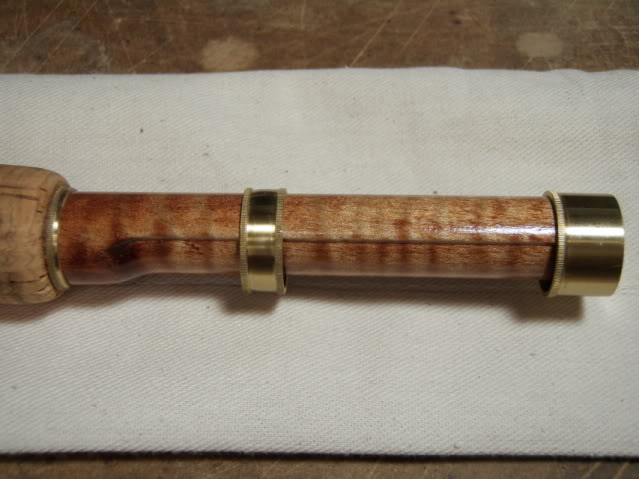Bamboo Tips - Tips Area |
|
< Home < Tips Area < Hardware < Ferrules < Material Sourcing
Anybody know of a source for NS rod? I know somebody asked this earlier but I missed it. Was curious to see if there was a cheaper source than where I am currently buying it. (Lee Orr) I've been getting mine up to 5/16" from Sheffield Knife Supply out of Florida. They will send cut lengths in both 6" and 12" if I remember right, and they're relatively cheap. It's the 18% stuff too. (Mark Wendt) Actually I needed rod for reel seat hardware 3/4" and at least at some 1". (Lee Orr) I get mine from Busby Metals on Long Island, NY. I purchase it in 1" diameter and 12 feet long. This will give you enough NS bar stock for reel seat hardware for a very long time. This was also the most cost effective source I could find. Goldenwitch sells or did sell, NS bar stock in smaller lengths. (Wayne Daley) Check out Jantz Supply. They have 1" diameter NS, 6 inches long. What they sell is 18% NS, but it tarnishes to a yellowish color. Polished up it is the regular silver NS color. (Darryl Hayashida)
Where should I go for aluminum and NS rod stock for ferrules? Looking for a couple feet of both. Is the 5/16ths big enough for 12, 13, 14, 15/64ths ferrules? Not interested in tube, already got some from Chris Bogart. Finally, how is it to machine silicon bronze? I assume that if Winston uses it, it's not bad functionally. Thoughts? (Joe West) I am a self-taught machinist so I am no expert, but I found Duronze to be awful to machine to a smooth surface -- maybe the aluminum content that keeps it gritty? I think Winston uses Duronze - not silicon bronze. Is Silicon Bronze brittle? I have never seen it used in any application where wall thickness is less than 0.125". (Chris Lucker) Try Sheffield’s Knife Supply in FL for Nickel/Silver rod. Not sure if they carry aluminum rod. However, Metal Express would carry the aluminum and possibly the Nickel/Silver rod, although I think they just sell hollow Nickel/Silver stock. (Bob Williams) Metalexpress.net seems to be the one-stop shop for the rodmaker. It seems a little expensive though. (Joe West) Silicon bronze is very tough stuff, more so than NS or AL. It is not brittle. It can be machined into very durable ferrules and reel seat hardware. You must keep your tooling sharp and use cutting oil especially when drilling or reaming. Polishes up like gold. Looks impressive on a rod. (Don Schneider) Thanks for the info about silicon bronze. Do you happen to know the alloy number that is readily available? Also, wondering about it color since you mentioned "Polishes up like gold." Sounds very interesting! (Ted Godfrey)
I found a place that sells 752 NS rod in sizes up to 1 inch in diameter, and the prices are fairly cheap. A foot of 3/8 is $6.16. 1/4, 5/16, and 3/8 are the most useful sizes for me. 752 alloy is the stuff I tried out that tarnishes to a yellowish color, although it is 18% nickel. They have an online ordering system, but for some reason you can only order up to 5/16 online. Larger than that you have to call them. Maybe they just haven't taken the time to list the larger sizes online. The place is www.jantzsupply.com (Darryl Hayashida) Got to nosing around after your post and found some interesting information on metals at the Metal Reference web site. There is an interesting chart here. If you browse through their site you'll find this information displayed several different ways. Unfortunately most of the 18% Nickel Silver is found in the form of wire or sheets. (Tim Wilhelm) Outstanding! I've been trying to find a cheaper source for the larger sizes too, and it seems everyone that sells the larger sizes either wants to sell in quantity, or wants your first born male child as payment. Thanks! (Mark Wendt)
I'm looking for a small amount of 7/8" diameter, 18%, solid bar stock nickel silver. I'm too lazy to do all the searching myself! (David Dziadosz) From a previous post: I found a place that sells 752 NS rod in sizes up to 1 inch in diameter, and the prices are fairly cheap. A foot of 3/8 is $6.16. 1/4, 5/16, and 3/8 are the most useful sizes for me. 752 alloy is the stuff I tried out that tarnishes to a yellowish color, although it is 18% nickel. They have an online ordering system, but for some reason you can only order up to 5/16 online. Larger than that you have to call them. Maybe they just haven't taken the time to list the larger sizes online. The place is www.jantzsupply.com (Darryl Hayashida) The rounds are available at metalexpress.net. They will even cut it in pieces for you. I buy it by the foot, and have it cut into three or four inch pieces. The real problem is that it is far easier and less expensive to make butt caps out of .650 x .720 tubing. For the end cap you can solder a piece of sheet NS, or turn a plug from the round stock and solder that in. However, I have run out of my small supply of tubing. If anyone knows a source, or has some they want to sell or trade let me know. My guess is that someone arranged for a run of this stuff some years ago as a group order, or they sold it to other rodmakers. I have several feet of the .680 ID thin walled stuff, but prefer the smaller .650 diameter for the cap and use the .680 stuff for the ring. (Jeff Schaeffer) Youch! $40 a foot, with shipping for a 12" piece of 3/4". Price does go down a bit buying multiples though. (Mark Wendt) You can also make an end cap with a nickel (5 cent piece) (Dave Norling) Yes, but they aren't nickel anymore. (Neil Savage) Not so. While pennies are made of copper-plated zinc, and "silver" coins are now made of a copper core clad with a 25% nickel - 75% copper alloy, nickels are made of the same "nickel-silver" alloy, but without the copper core. See this link. (Robert Kope) The site you reference (U.S. Mint) says "25% nickel, balance [75%] copper. Not to say it won't work, but it's not really nickel. OTH, I don't know the composition of 18% nickel silver. (Neil Savage) There are many different formulations of alloys which fall within the general term of "Nickel Silver". All contain copper, nickel and zinc, while some formulations may additionally include antimony, tin, lead or cadmium. A representative industrial formulation (Alloy No.752) is 65% copper, 18% nickel, 17% zinc. In metallurgical science, such alloys would be more properly termed nickel bronze. Some nickel silver alloys, especially those containing high proportions of zinc, are stainless. Nickel-silver alloys are commonly named by listing their percentages of copper and nickel, thus "Nickel Silver 55-18" would contain 55% copper, 18% nickel, and 27% other elements, most probably entirely zinc. A two-element alloy may be named for its nickel content alone, thus NS-12 is 88% copper and 12% nickel. (Larry Blan) Thus nickels are not nickel silver which is an alloy of 55% Copper 27% zinc 18% nickel (Ralph Moon) Nickel and copper have a similar internal structure, and will alloy seamlessly in any proportion. There are a large number of alloys. High nickel, low copper alloys are high strength, high corrosion resistance, and are called monels. They are generally made by the nickel producers, like International Nickel. The low nickel end of the spectrum is the nickel silvers, which are made by the copper companies. Go to the Olin Brass web site, click on "copper alloy guide" and you will get a chart of the common coppers, brasses, and nickel silvers. 752 and 762 are the ones most commonly used by rodmakers. Not on the chart is 792, which contains a little lead, to make it free machining. You will run across it if you look around a bit. Nickel silver was named because it looks like silver, and was (is) used in place of silver in less expensive jewelry and tableware. (Tom Smithwick) I'm not sure how a nickel would look if it were polished, but the ones in my pocket don't look anything like my nickel silver reel seats. Maybe the mint coats them with something? (Neil Savage) I was told that nickel silver was an ersatz development in wartime Germany (hence the German silver appellation) maybe during WWI? Any truth to that? (Art Port) Whoever told you that is mixed up. The alloy is an early one, and was apparently developed in China. The Germans did develop the modern alloys in the early 19th century, and marketed them to the world. War had nothing to do with it. There were some stainless alloys developed here in WW2 that substituted manganese for nickel, and perhaps that is what your source may have been thinking about. (Tom Smithwick) "Nickel Silver", (also known as German Silver) is a nickel-copper alloy. 12% nickel silver (NS12) is 12% nickel, balance copper, and has a bit of a pinkish hue. 18% nickel silver is 18% nickel, balance copper. It has more of a silver color, and a "warmer" glow than you'd see in regular Sterling Silver (which, by the way is 92.5% pure silver, if memory serves). US minted "nickels" are 25% nickel, balance copper (well, maybe some zinc). Which means they contain more nickel than standard 18% nickel silver ferrules, winding checks, etc. And by the way, you won't enjoy trying to work pure nickel. It's an extremely hard metal, and won't respond well to turning, forming, etc. Hence the copper... My guess (purely that) is that it was originally called nickel "silver" because it was less expensive, but had similar machinability properties as true silver. (Tim Preusch)
I'm searching for a source of nickel silver 3/8" round bar stock. I'm looking to do some initial work on ferrule making. Any leads that you all might supply would be most welcome. (Paul Julius) Jantz Supply has it in stock p/n an124 $11.95 for 12 inches Phone is 800-351-8900 web site. (Gary Nicholson) Busby Metals out east quoted $12/foot. Expensive stuff. Why don't we all use Duronze instead of the Nickel silver?? (Paul Julius) I get most all of my nickel silver bar stock, except for the large sizes from Sheffield Supply. (Mark Wendt) - or - Thomas Net. (Ren Monllor)
I'm ready to fire up the new lathe and start turning (ruining) metal for reelseats and other hardware. Bill Harms book describes using brass. Aluminum is also cheap and available. Who uses brass? How has it turned out for you? Some aluminum reelseats appear to be polished to a fine finish, looking almost like nickel silver. How do you do that? (Dave Kemp) Actually, instead of brass, I'd recommend Duronze (alloy 642). Brass is very heavy, while the Duronze is lighter than nickel silver. It can be purchased in flat sheets or solid rod stock, and is FAR less expensive than nickel silver. Its natural color is somewhere between brass and nickel silver, and it can be blued or left to "age" on its own. Final finishing is a function of different polishing grits--from 1200-grit wet-or-dry paper to a rottenstone slurry. You can get any effect you like. (Bill Harms) In The Planing Form was a link to articles on ferrule making written by Bill and Tom. Good stuff in here. (Scott Grady) And then there's 1/4" stainless steel pipe. Hard to work with but most of the work is done for you if you start with a pipe, and it's already got a tapered thread if somebody wanted to save that work too. It polishes up to look as good as any metal and it's tough so it can be reduced to a fine thickness. And the price is sure right! Anybody tried stainless yet? (Don Ginter) Depending on the type of Stainless, they can be tough to machine. I'd suspect 316 is pipe material whereas 416 maybe where you should be looking. I've machined stainless - tough on both tools and temper - mine. (Don Anderson) I make reel seat hardware and ferrules out of 303 stainless steel. I use the stainless steel hardware on reel seats that will be used in salt water and 6061-T6 aluminum for reel seats used in fresh water. 7075 aluminum also works well. Yes, I think it is 316 but I've machined it too and it can be done. If one can persevere with the machining, then they will end up with a practically indestructible reel seat that would be second to none in appearance. For next to nothing. I've never tried a reel seat out of stainless but I've made a few rings and other jewelry items. Just an idea though and still wondering if anybody's turned out a reel seat. (Don Ginter) Wondering if anybody's turned out a reel seat. Here's one with stainless cap and ring, brass knurled cork check and butt insert. The stainless is 304 cut from tubing. Nasty to cut, but very light and strong. The wall is .025, and I have cut rings under 1/8" long for light rods. It will not deform, even at that width. The wood is American Holly, BTW. I have not gotten into threaded reel seats.
(Tom Smithwick) Looks very nice Thomas. Are you intending to continue with stainless or was this just an experiment? (Don Ginter) I intend to use the stainless whenever I use a ring and ring seat, or a cap and ring. I 'm not interested in being in the reel seat business, but I do sell the rings for $5.00 apiece to those who want to try them. You are on your own for fillers, or the butt end pieces. The rings are .685 ID, and if you file the ridges of a US dime coin lightly, the dime will force fit into the tubing for an end cap. I have played around a little with using the lathe to engrave brass butt caps, too, but don't sell them. You set a tool on edge in the tool post and draw it across the part, taking off about .005 per pass.
(Tom Smithwick) While on the subject, how much is known about the Nickel-Silver '932' with respect to its practical use for reel seat hardware and/other parts, {compared with brass, etc. for example}? (Vince Brannick) Since it's been used in that respect for over 100 years, I would bet there's quite a bit of empirical knowledge about it in that respect. Maybe I'm misinterpreting your question, but what would you like to know about it, specifically? (Mark Wendt) Nickel Silver '932'(?) may be an incorrect designation. (haven't located the paper work). Recently purchased some nickel silver that has a different cast to it than the 18 percent nickel silver material. Some research has revealed that it may have a nickel content of around 10 percent. In view of the diverse materials used over many years in the fabrication of rod hardware components, it would seem to be acceptable for such parts as butt caps, screw-lock/slide rings, etc. With respect to ferrules however, my question is what are the objections to using it as compared with any other alternative material(s) to 18 percent nickel silver? Thanks for any response. (Vince Brannick) Ah, okay. From what I've seen of it and machined, it machines pretty much the same as the 18%. Tom Smithwick would be better at talking about the metallurgy and the strengths of the material in that kind of use. The one thing I have noticed with nickel silver at less than the 18% concentrations is that it doesn't blue as well using the stuff we typically use like Jeff Fultz's or Bob Nunley's solutions. I've not used the Payne formula, so I can't comment on how well that works. With the less than 18% NS, when bluing I'm more apt to get a mottled finish, or one that's not quite as dark as it would be on the 18% stuff. (Mark Wendt) CDA-932 is a bearing bronze, high lead/tin content. I don't think you want to use that material. CDA-752 what we term 18% is the standard for ferrules, if another alloy was better I'm sure the rod shops of the past would have switched to it. 12% can be used for reelseats, caps etc. But really is a poorer choice for ferrules. Sometimes there are issues with bluing the 10-12% That said some people use it. Considering the above the %'s have a range ex: the 18% I believe is 16-19% is acceptable Been a while since I check these facts, but I think they are pretty accurate. (James (JED) Dempsey) I use brass for my cap, slip rings and ferrules and I am happy with it. I blue it for a nice aged effect to compliment the anodized (black) guides I'm using now. While brass is heavier I find that most of the times I need to use "heavy" reels to find a nice balance for the rod so the very slight weight difference of the finished hardware has not bothered me but possibly helped. (Mike Monsos) Aluminum alloys are many. 7075 really takes a shine and doesn't oxidize like some of the other aluminum alloys. Due to its strength, high density, thermal properties and its polish ability 7075 is widely used in mold tool manufacture. (Don Anderson) I almost exclusively use Nickel Silver, but have used Aluminum in the past. What I used was 6061 bar stock and turned cap, ring and cork check out of it. You can turn it on a lathe, then hit it progressively with 320, 400, 800, 1000, 1200, 1500, 2000, then polish it out with a buffer and it is a shiny and bright as anything you will ever see. With today’s modern tempers and alloys, Aluminum can make a great reel seat plus it does save a lot of weight compared to the same size components made of Nickel Silver. The process I described sounds LONG, but really, we're only talking about 10 minutes of sanding and polishing per part, to get that kind of mirror finish (which really isn't necessary, but does look good). All that being said, I'm will Bill on this one. If I were to go away from Nickel Silver, I would definitely go with Duronze... Stuff works well (if you don't let it get too hot), polishes out well and when you blue it, you can get the prettiest midnight blue you ever saw (talking about using my bluing formula on it... shameless self-promotion! (Bob Nunley) I've seen some really cool hardware with mixed and matched metals and various finishes, Garrison used to do that, which makes a lot of sense. From a purely practical standpoint it probably makes more sense to leave the materials with a matte finish, but that mirror finish sure looks pretty! A few total newbie questions - how are folks cutting their threads, internal and external? I have a Sherline with the thread cutting attachment (it came with the lathe) but since it doesn't have power feed, I was wondering if maybe I might just be better off buying a tap and die. Does anybody cut their internal threads with the lathe or is it more common just to tap them? Also, for using tubing, what tubing diameters are folks using for the screw nuts and thread barrels? I'll have to check diameters of what I have, but I think I've got some smaller NS tubing that's got an OD about .695 only a few thou larger than the ID of my standard sized stock (740 OD .690 ID if I remember). Would a combo like this work for making a threaded seat? Seems like it should. (John Rupp) A while back I was browsing at a local flea market when I ran across an old fiberglass blank. One of the old brown ones in a 7' 6" 4wt. It had been ferruled with a brass Super Z, and had the cork grip with it. Someone purchased it from E. Hille Angler's Supply House in Williamsport, PA (it still had the sticker on it). Anyway, since it had a brass ferrule I decided to make brass hardware for the seat. I just tried to weigh the brass, and nickel bars to see about what the difference would be. It really didn't appear to be that much, and it actually made a pretty nice seat. If it works, I attached a couple photos.
Pretty real seat Floyd. That brass looks nice against the wood filler. (Mark Wendt) Yes, that would be nice blank. I have several of those I made back in the early 1960's - whoa, did I really say that. I am originally from the Williamsport area, so those blanks are familiar to me as I have made several of them into nice casting flyrods. They are sitting in my fly shop; I really need to get them out again and fish with them. (Frank Paul) The gold Z's were made with an alloy they called "Broloy" probably a nickname for silicon bronze, Duronze or whatever. They will take bluing. (James (JED) Dempsey) I have some of these broloy ferrules, mostly 15/64", a few 17's, 19's and 21's They also do not have a water seal on the female. The ferrules I have are coated with a black paint like substance. instead of what you might expect in blued ferrules. The paint can be removed easily if required. When they were machined they were to the correct size for the fit, no extra fitting required. The ones that I have do not have the SuperZ stamp, the ladies where still making the ferrules after the trademark had been sold to Cortland? They were packaged in 10's, and wrapped in the newspaper of the day, one package I have has a date of 1961.
Does anyone know of a supplier of 18% NS bar stock? The only supplier of NS I can find is Online Metals and they supply it in sheet only. (Joe Aversa) Jantz Supply. (JW Healy) Jantz Supply sells bar stock in 12" lengths. For larger orders I recommend National Bronze and Metals in Houston, Texas. The last time I ordered from them they had a $250 minimum. (Lou Barbaro)
|





